When we're shopping for a generator, we'll often see two distinct power ratings that can cause confusion: starting watts and running watts. These numbers aren't just marketing jargon – they represent vital differences that could mean the difference between a generator that meets our needs and one that leaves us in the dark. While running watts tell us how much continuous power our generator can provide, starting watts reveal a more complex story about the surge capacity needed for motorized appliances. Let's explore why understanding these ratings is essential for making an informed decision and protecting our investment.
What Are Starting Watts
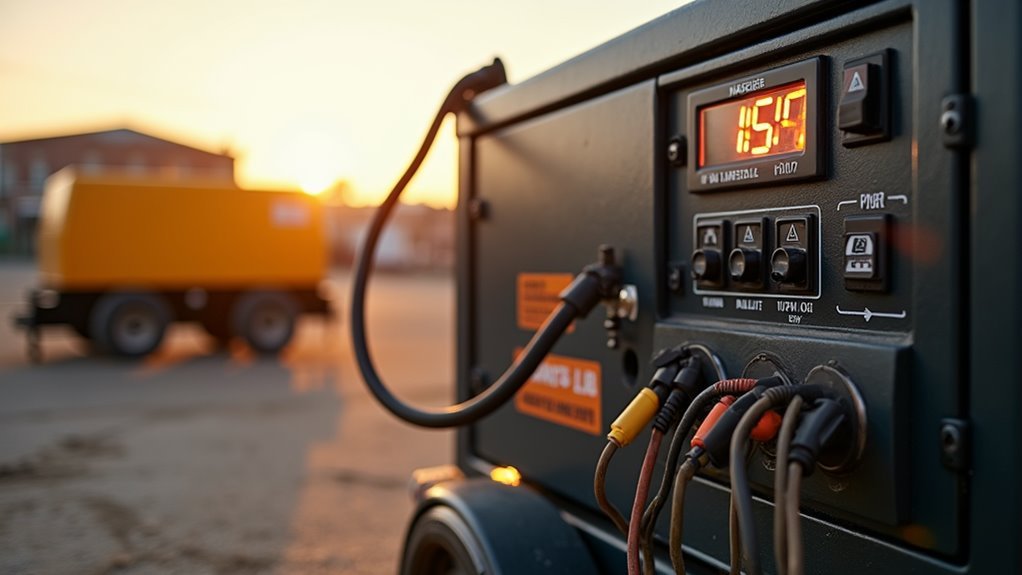
Starting watts, also known as surge watts or peak watts, represent the extra power that electrical devices need during their initial startup phase.
When we turn on appliances like air conditioners, refrigerators, or power tools, they require a significant boost of power to overcome inertia and get their motors running. This initial surge typically lasts for just a few seconds but demands much more power than normal operation.
Let's break this down with a practical example. When we start our refrigerator, its compressor motor needs about three times more power to kick into action compared to what it uses during regular running time.
That's why we can't just look at running watts when choosing a generator – we've got to account for these starting watts too.
Understanding starting watts helps us avoid overloading our generators. If we don't have enough starting watts available, our appliances mightn't start at all, or worse, we could damage both the generator and our equipment.
That's why it's essential to calculate these surge requirements before connecting any heavy-duty appliances to our power source. Additionally, proper installation practices can prevent potential damage to the generator during high-demand scenarios.
Understanding Running Watts
While starting watts represent the initial power surge, running watts tell us how much continuous power an appliance needs during normal operation.
Think of running watts as your appliance's steady-state power requirement – it's what you'll need to keep things humming along after that initial startup boost.
Let's break this down with a practical example. When you're using a refrigerator, it might need 2,200 starting watts to kick on, but only 700 running watts to stay operating.
We'll need to account for these running watts when choosing a generator to make sure it can handle our power needs over extended periods.
To calculate your total running watts, we simply add up the running watts of all the appliances you plan to use simultaneously.
If you're powering a refrigerator (700W), microwave (1000W), and a few lights (200W), you'll need at least 1,900 running watts.
This gives us a clear picture of how much continuous power our generator must provide to keep our essential appliances running smoothly during an outage or while off the grid. Additionally, regular exercise and maintenance of your generator will ensure it can deliver the necessary steady-state power requirement consistently when you need it most.
Common Power Surge Examples
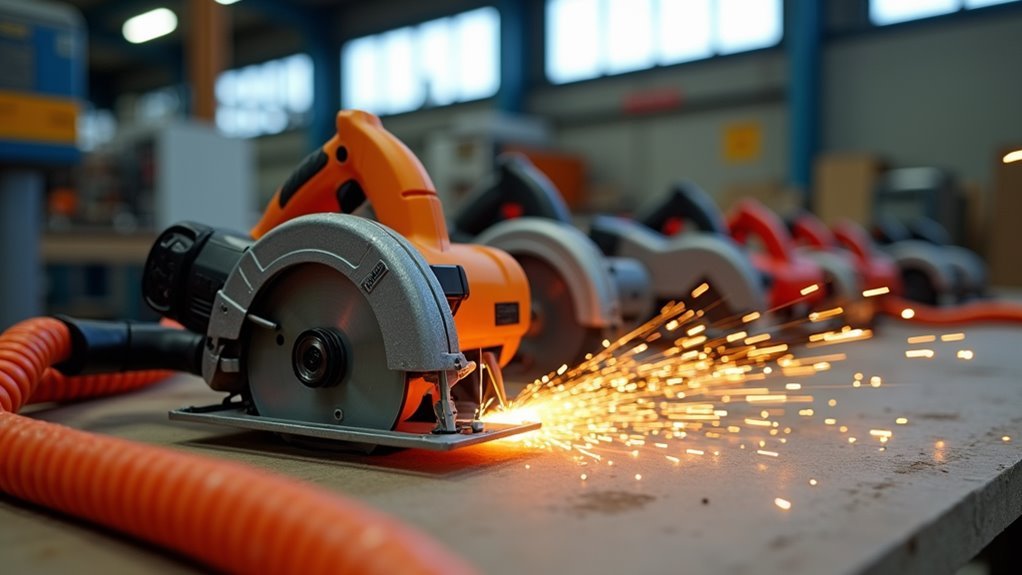
Understanding power surge patterns helps us make smarter decisions about generator capacity.
Let's look at some everyday examples of power surges that we all encounter. When your refrigerator's compressor kicks on, it needs about three times its running watts for a few seconds. Similarly, your air conditioner typically requires four to five times its running power to start up.
We'll often see power tools creating significant surges too. A circular saw that runs at 1,200 watts might need 3,000 watts to start, while an air compressor can demand up to six times its running watts initially.
Even smaller appliances like microwaves and coffee makers can create brief power spikes when they first turn on.
In your workshop, pay special attention to equipment like drill presses and table saws – they're notorious for high starting demands.
The same goes for well pumps, which might need 2,000 to 4,000 starting watts but only 750 to 1,500 running watts.
Calculating Your Power Needs
Now that we've seen these common surge examples, let's determine how much power you'll actually need from your generator. The key is to list all the appliances and tools you'll want to run, then add up both their running and starting watts. We've created a simple table below to help you track your essential items.
| Appliance | Running Watts | Starting Watts |
|---|---|---|
| Refrigerator | 800 | 2,300 |
| Window AC | 1,200 | 3,600 |
| Sump Pump | 1,000 | 2,200 |
| Well Pump | 1,000 | 3,000 |
| Space Heater | 1,500 | 1,500 |
To calculate your total needs, first add up all the running watts of items you'll use simultaneously. Then, identify the item with the highest starting watts – that's your surge requirement. Add this surge amount to your running watts total. Don't forget to leave a 20% buffer for safety and future needs. This method guarantees you won't overload your generator when multiple items kick on at once.
Startup Power For Major Appliances
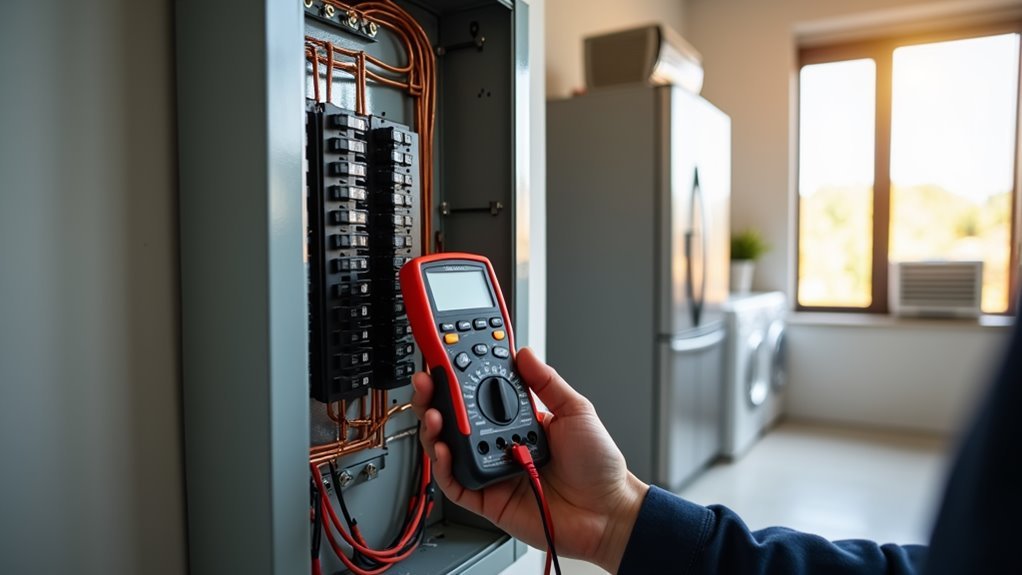
Major appliances place significant demands on your generator during startup, with some requiring up to three times their running wattage to get going.
We've found that understanding these startup requirements is essential for keeping your power flowing when you need it most.
Let's look at some common appliances and their typical startup demands.
Here are the most power-hungry appliances during startup:
- Air conditioners need 2,800-3,600 starting watts but run at 1,000-1,200 watts once going
- Refrigerators surge to 2,200 watts at startup before settling to around 700 watts
- Well pumps demand up to 4,000 starting watts while operating at 1,000-1,500 watts
- Electric water heaters spike
Generator Sizing Made Simple
Proper generator sizing boils down to a simple formula: add up your essential running watts and account for the largest startup surge.
Let's walk through this together to make sure you've got a generator that won't leave you in the dark when you need it most.
First, we'll list all the appliances and devices we want to power simultaneously. Write down their running watts and starting watts – those numbers we covered earlier.
For example, if we're powering a refrigerator (running: 800W, starting: 2,400W) and a window AC (running: 1,000W, starting: 3,000W), we'll add the running watts together: 1,800W total.
Now here's the vital part: we need to factor in the highest startup surge. Between our two appliances, the AC needs 3,000W to start – that's our biggest surge.
Avoiding Common Sizing Mistakes
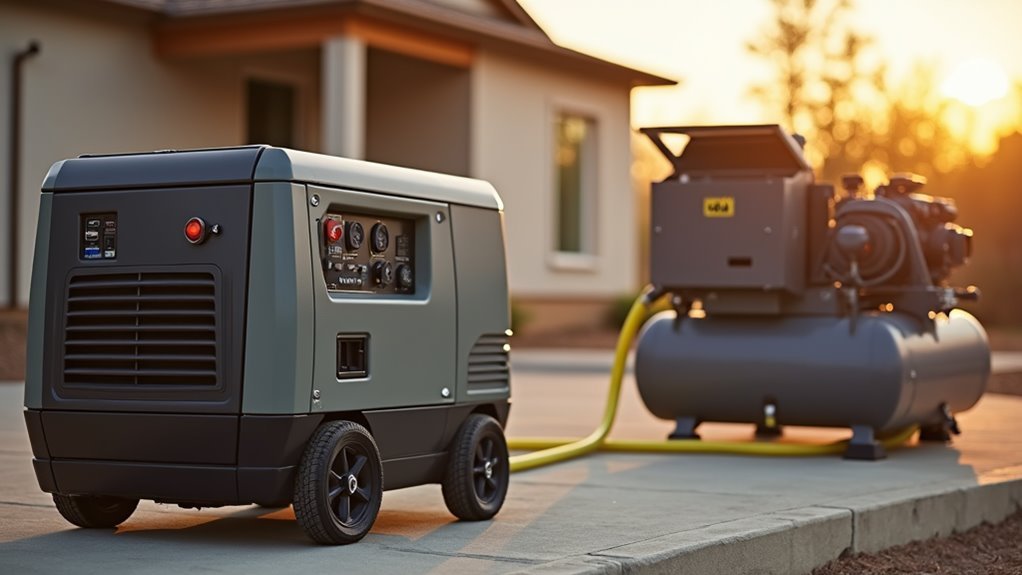
While calculating generator size might seem straightforward, many people make costly mistakes that leave them with insufficient power. Let's explore the most common sizing errors so we can help you avoid frustration and protect your equipment.
We've seen these critical mistakes happen time and time again when folks try to size their generators:
- Only adding up running watts without considering starting watts, leading to overloaded circuits when motors kick in.
- Forgetting to count all devices that might run simultaneously, like when your AC kicks on while the fridge is running.
- Relying on "rule of thumb" calculations instead of checking actual equipment specifications.
- Not planning for future needs or seasonal changes in power requirements.
Don't fall into these traps – they'll leave you powerless when you need electricity most.
We recommend listing every appliance you'll run, finding both their running and starting watts, and then adding a 20% safety margin. This way, you'll have the freedom to use your equipment without worrying about overloads or damage.
Power Management Strategies
Smart power management can make even a modest generator handle your essential needs effectively. We'll teach you how to get the most from your generator by strategically managing your power usage.
Let's start by rotating high-demand appliances rather than running them all at once. When we're using the microwave, we'll wait until it's done before starting the toaster. This simple strategy prevents overloading and lets us run more devices with a smaller generator.
We can also prioritize our needs during outages. Essential items like refrigerators, well pumps, and heating systems come first. Then, we'll add comfort items like coffee makers or TVs only when we've available capacity. It's helpful to create a list of our appliances' running and starting watts, keeping it handy for quick reference.
Don't forget about power-saving tricks, like using LED bulbs instead of traditional ones, or running the washing machine with cold water.
These small changes add up, letting us power more devices without upgrading our generator. By being mindful of our power consumption, we're ready to handle outages efficiently.
Protecting Your Generator Investment
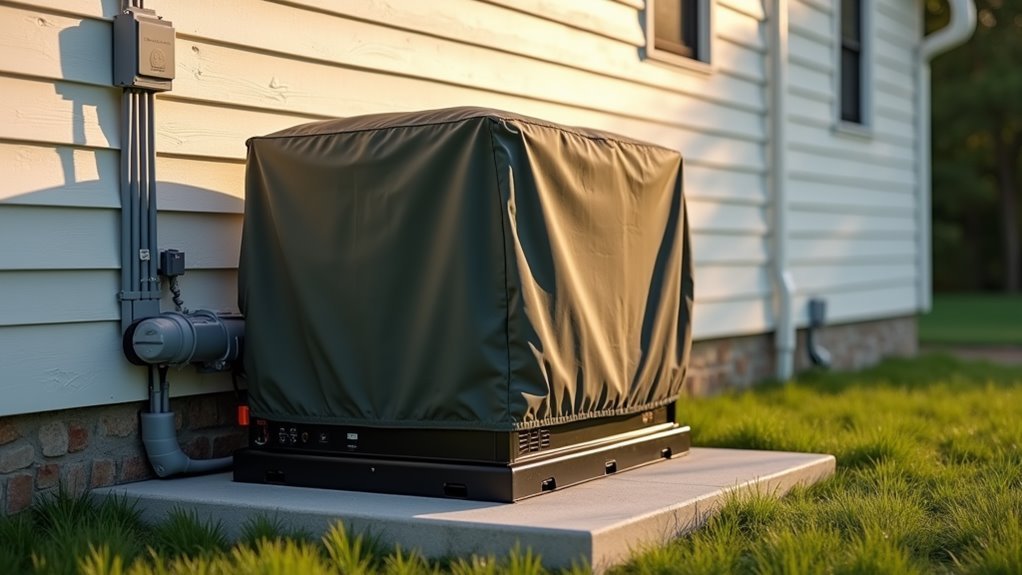
Now that we've optimized our power usage, let's focus on protecting the generator that makes it all possible.
Our generator represents both a significant investment and our ticket to energy independence, so taking proper care of it just makes good sense.
Regular maintenance and smart operating practices will keep our power flowing reliably when we need it most.
To help visualize what proper generator care looks like, here are the essential protective measures we need to follow:
- Keep it covered with a well-ventilated, weatherproof enclosure when not in use, protecting against rain, snow, and harsh sun.
- Run the generator at least once every 30 days for 20 minutes to prevent fuel system issues and battery drain.
- Change the oil according to the manual's schedule, typically every 50-100 operating hours.
- Store it in a dry, clean location with fresh fuel and a full tank to prevent moisture buildup.
Emergency Load Planning
Determining how to allocate your generator's power during an emergency shouldn't be a last-minute decision. We need to create a solid plan that prioritizes our essential needs while making the most of our generator's capacity.
Let's start by listing our must-have appliances and their power requirements.
First, we'll focus on survival basics: refrigeration for food safety, heating or cooling depending on the season, and essential medical equipment if needed.
Next, we'll add critical communication devices like phones and emergency radios. Remember, we can't run everything at once, so we'll need to rotate some appliances.
Creating a schedule helps us manage our power usage effectively. We might run the fridge for an hour, then switch to the microwave for meals, and later power up communication devices while they're charging.
It's also smart to keep a power strip handy – this makes it easier to switch between devices without unplugging everything.
Frequently Asked Questions
Can Starting Watts Damage Appliances if the Generator Is Oversized?
We can't damage appliances with higher starting watts from an oversized generator. Your devices will only draw the power they need, making larger generators safe for smaller loads.
Do LED Lights Require Different Starting Watts Than Traditional Bulbs?
Like a feather compared to a brick, LED lights don't need extra starting watts at all. We can power them instantly, unlike traditional bulbs that demand more juice to get going.
How Does Altitude Affect a Generator's Starting and Running Watts Capability?
We'll notice our generators lose about 3.5% power capacity for every 1,000 feet above sea level, affecting both starting and running watts. You'll need higher-rated units at elevation to match sea-level performance.
Are Starting Watts Different in Cold Weather Versus Warm Weather?
We'll face harder generator starts in cold weather, needing more starting watts than in warm conditions. Cold oil's thicker, engines resist turning over, and batteries don't perform as efficiently.
Can Using a Soft Start Device Eliminate the Need for Starting Watts?
While we can't fully eliminate starting watts, soft start devices are our allies in considerably reducing that initial power surge, letting us get by with smaller, more affordable generators.
Conclusion
We've learned just how critical it is to understand both starting and running watts for our generators. While it might seem complex at first, we now know that proper planning prevents those frustrating power failures when we need electricity most. By carefully calculating our needs and following smart power management strategies, we'll keep our generators running smoothly and our homes powered safely through any situation.